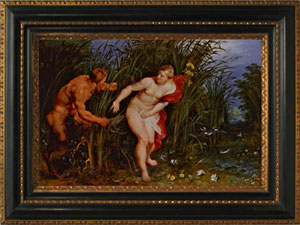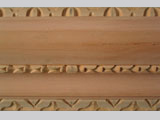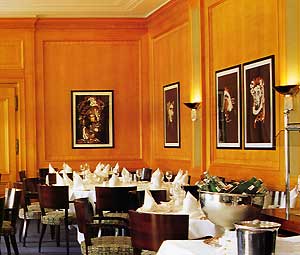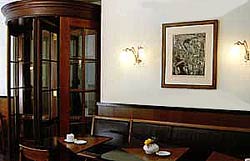| virtual Studio | References | Workshops | Styles of Frames | History | Collection | Gallery | ||||||||||||
|
|
||||||||||||||||||
| Selected Reference Projects | ||
| Albertina, Vienna Old Pinakothek, Munich Augsburg Town Hall Cuvilliés Theatre, Munich Felix Nußbaum House, Osnabrück Franciscan Church, Salzburg Frauenkirche, Munich Hirschhorn Museum, Washington Hotel Elephant, Weimar Art Museum Basel Art Hall Bremen Art Hall Karlsruhe Art Hall Kassel Art Hall Mannheim Art Hall Nuremberg Kurpfalz Museum, Heidelberg Liechtenstein Museum, Vienna Lenbach House, Munich Marburger University Museum Mauritshuis, Den Haag |
Minneapolis Institute of Arts Museum Ulm Museum Villa Stuck, Munich New Pinakothek, Munich Pfalz Gallery Kaiserslautern Private Collections - Sandro Botticelli "Madonna" - Michelangelo Pistoletto "About the Mirror" Restaurant Roma, Munich Salzburger Baroque Museum Collection Dr. August Oetker Collection Frieder Burda Collection Georg Schäfer Collection Walter Scharf State Museum Berlin State Museum Kassel Städel Museum, Frankfurt Wallraff-Richartz Museum, Cologne Veste Coburg |
|
| Press releases Special projects |
||
|
|
||
| The Städel Museum, Frankfurt Old Masters Picture Gallery Jan van Eyck "The Lucca Madonna" Reconstruction of the Frame Setting for The Städel Museum, Frankfurt am Main “No other painting by Jan van Eyck conveys such an immediate sense of intimacy between the observer and the figure represented as the Lucca Madonna, named after one of its previous owners. In addition to the insightful observation of the emotional relationship between mother and child, the masterful use of light and shadow and, above all, the apparently incidental but in fact highly sophisticated depiction of space in the painting create this effect. The precious oriental carpet on the floor continues into the perceived space, just as the windows piercing the walls and the rib vault of the ceiling of the throne room extend beyond the frame. The observer does not experience this picture as if viewing a theatrical scene, as is the case with the Madonna panel by Petrus Christus. Instead, the viewer is drawn into the very space in which the Queen of Heaven is nursing her godly child.” The reproduction of the framework for the painting by van Eyck arose from Dr. Jochen Sander and the Pfefferle company working together in close co-operation. An original frame of a comparable picture by van Eyck hanging in the national painting collections in Dresden was used as a master copy. There the setting was studied exhaustively and transferred to the frame for the Städel museum. The basecoat consists of a special crackle whiting in order to imitate the antique surface in the best possible way. The setting itself is a painted marbling as was usual for this period. |
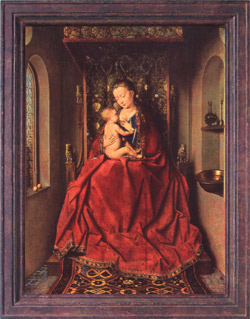 Jan van Eyck, ca 1390 - 1441 The Lucca Madonna framed Tempera and oil on oak, 66 x 50 cm Frame: Painted marbling on a special crackle whiting base 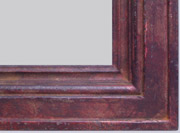 Detail of the marbled setting |
|
 |
||
|
|
||
State Museum in Kassel Old Masters Picture Gallery Peter Paul Rubens and Jan Brueghel the Elder "Pan und Syrinx" Reconstruction of a picture frame from our collection for the State Museum in Kassel “In 2002 the State Museum in Kassel was successful in obtaining in the most important acquisition of the past 100 years for the Old Masters Picture Gallery: Pan and Syrinx, ca. 1617 by Peter Paul Rubens and Jan Brueghel the Elder produced as a joint work of art…” Extract from the brochure of the exhibition: "Pan and Syrinx – An Erotic Hunt" An original frame from our collection was used as a model for the reconstruction of this picture frame. As the original frame seemed to be too massive for the painting, it was decided to reduce proportionally the profile of the reconstruction by one centimetre. The circumferential gilded ornamental staves were correspondently scaled down and carved finely and filigree from linden wood by our sculptor. Just like the original frame, the reconstructed frame consists of a specially prepared blank frame made from soft pinewood on which a moulding made from pear wood with mitred joints is glued. The carved ornaments are bole gilded, the main moulding from pear wood is stained dark. The exhibition lasts from 19th March 13th June 2004 The Frame-making Process |
|
|
|
The fine detail of the circumferential composition ornaments. |
||
 |
||
|
|
||
Albertina, Vienna Albrecht Dürer “Dead European Roller” and “Wing of a European Roller” Reconstruction of a picture frame from our collection for the Albertina Museum in Vienna A completely new frame concept under the management of the current director Klaus Albrecht Schröder was developed for the world-famous collection belonging to the Albertina museum in Vienna. |
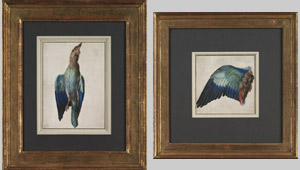 Albrecht Dürer, Dead European Roller, 1512 Albrecht Dürer, Wing of a European Roller, 1512  Detail of the embossed frame. |
|
 |
||
|
|
||
Pfalz Gallery Kaiserslautern Arnold Böcklin "Nessus und Deianira" Reconstruction of a picture frame for the Pfalz Gallery Kaiserslautern For the occasion of the exhibition “Grotesque! 130 years of The Art of Impertinence” in the Schirn Art centre in Frankfurt, the painting “Nessus and Deianira” by Arnold Böcklin (1898, timber panel, 104 x 150 cm) was newly framed. The frame had not only to meet the historical requirements put upon it, but also be adapted to the proportion and size of the painting. A foliate motif frame was decided on with the three-dimensional ornamentation decoration that Böcklin preferred for his pictures, the only model for the frame being the illustration of a Böcklin picture in an exhibition catalogue. The frame with all its individual production steps was custom-made in the Pfefferle workshops. The carpenters’ workshop produced the work drawings and ground special, purpose-made cutters with which to carve the basic profile. Leaf ornamentations by our sculptor were carved into the blank moulding consisted of plain and profile frames. The preparation of the undersurface was particularly complex as it was important to retain the sharp outlines of the ornamentation (see also Workshops). Finally the frame, overlaid in gold leaf, was tinted. Tinting particularly requires a lot of experience: if it fails in the first processing step, the framework must again be gilded. |
|
|
|
Detail of the hand-carved Acanthus-foliage ornamentation. |
||
 |
||
|
|
||
Old Pinakothek, Munich Martin Schaffner "Altar Painting" Re-framing of the winged alter for the Old Pinakothek in Munich The multi-part, winged altar was painted by Martin Schaffner (ca 1478-1549) for the High Altar of the Augustiner-Chorherren-Stiftskirche in Wettenhausen. The tablets are dated and originated in the years 1523-24. At the end of the 17th century the painting was replaced by a baroque altar, and in 1803 following secularisation it entered into state hands. In the 1960s the painting was again re-framed on request of the Bavarian State Painting Collection. A preserved, historical frame mounting for a Schaffner altar in the district of Ulm served as master copy. The outlines are gold-leafed on a bole foundation. The filigree rosettes and the stylised leaf ornamentations were produced by our sculptor. The patterned area is especially accentuated due to the blue-pigmented underlay. |
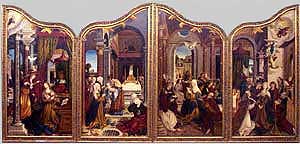 Martin Schaffner, High Altar of Wettenhausen near Ulm, 1523 - 1524. Cassetta frame with gilded outlines. The blue under-laid patterned area is decorated with stylised leaf ornamentation. The filigree, openwork shapes are hand-carved from linden wood.  |
|
 |
||
|
|
||
Augsburg Town Hall Reconstruction of the picture frames in the Golden Hall For the restoration and reconstruction of the interior decorations of the “Golden Hall” (one of the most important examples north of the Alps of the transition from the Renaissance to the Baroque style forms) in the Augsburg Town Hall, which were totally destroyed during the 2nd World War, the Pfefferle establishment took over the reconstruction of the picture frames. During the war, the pictures were stored elsewhere but the frames made of walnut wood were burnt during an air raid. The work involved demanded extensive investigation as there was only a poor-quality photo in existence. The frames had to be fitted exactly between the wood-panelled walls and the coffered, recess-panelled ceiling. |
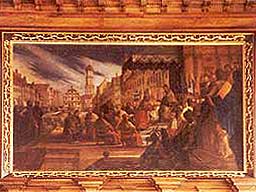 Artwork over the wall panels in the „Golden Hall", Augsburg Town Hall, Elias Holl, 1615-1620 |
|
 |
||
|
|
||
Kurpfalz Museum, Heidelberg Jakob Jordaens "Holy Family" Reconstruction of a picture frame from our collection for the Kurpfalz Museum, Heidelberg In 2002 the painting “Holy Family“ by Jakob Jordaens was re-framed by the Pfefferle Frame-making Workshop. The picture frame was chosen on the basis of photomontages (compare: virtual studio). This way, the picture did not have to be transported from Heidelberg to Munich and back. The reconstructed frame was delivered to the museum in such a way that the painting only had to be inserted. |
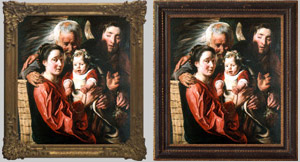 The image on the left shows the finished Jakob Jordaens painting, framed by the Pfefferle Workshop in 2002. |
|
 |
||
|
|
||
Cuvilliés Theatre, Munich Total construction supervision for the restoration of the Cuvilliés Theatre in Munich In 1956 the House of Pfefferle received the total construction supervision for the restoration of the settings of the Cuvilliés Old Residence Theatre in Munich, which had been completely destroyed in 1944. Otto Meitinger, who was the then executive director of the Residence construction committee and later plenary Professor for Design and Conservation of Historic Buildings at the Technical University of Munich, wrote: “The reconstruction of the Cuvilliés Residence Theatre was undoubtedly the most interesting task in rebuilding the Munich Residence, and furthermore was arguably also the highest regarded conservation project in Bavaria in the first post-war decades.” |
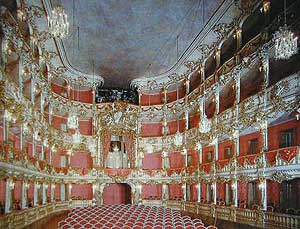 The fully restored Cuvilliés Theatre |
|
 |
||
|
|
||
|
Re-framing of the Felix Nußbaum Collection for the |
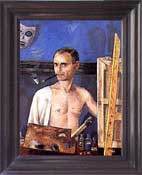 Felix Nußbaum Self-portrait with easel, oil on canvas, ca 1933 |
|
 |
||
|
|
||
|
Restoration and reconstruction of Johann Fischer von Erlach's High Alter |
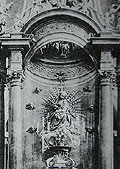 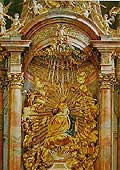 High Alter of the Franciscan Church in Salzburg Left image condition in 1939; Right image condition now. |
|
 |
||
|
|
||
|
|
 Franz von Stuck, The Temptation of Saint Anthony, 1918. Flat frame with wavy outlines modelled on Stuck’s frame concepts    Three possible variations for the framework according to Franz von Stuck’s frame concepts |
|
 |
||
|
|
||
Private Collection Sandro Botticelli "Madonna with Child" Re-framing the picture After an extensive restoration of the picture, the owners decided to have the picture re-framed. Style and geography demanded the use of a Tabernacle frame. However, there are so many lavish variations and forms in this type of frame that is was necessary to give a lot of thought as to how far the reconstruction of such a frame was allowed to become a separate architectural entity in its own right. “In all cases in which there are no essential designs or photographs of the original picture frame available, I tend to choose a preferably simple and scaled down framework in keeping with the authentic characteristics of the established period of the painting’s creation. In the case at hand, a relatively unostentatious Tabernacle frame from our collection was used as master copy. "The ornamentation shapes were taken from the Tabernacle frame of the picture “Madonna with Child” by Leonardo da Vinci.” (Karl Pfefferle) |
 New framework: Sandro Botticelli, Madonna with Child Simple Tabernacle frame with chased ornamentation on the sides of the frame |
|
 |
||
|
|
||
Cafe und Restaurant Roma, Munich The café-restaurant Roma lies on Munich’s famous saunter promenade: Maximilian Street. It was restyled in 2001 according to drafts by the designer Ingo Maurer. A focal point of the décor is the extra-large crystal glass mirror, designed and crafted by the Pfefferle Frame-making Workshop. The Karl Pfefferle Gallery fitted out the rooms with works by, among others, Jiri Georg Dokoupil, A.R. Penck and Elvira Bach. The paintings were framed in such a way as to suit the interior decoration as well as the showing the artwork to its best advantage. |
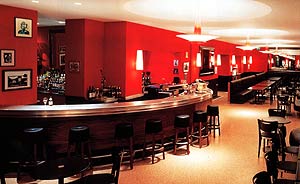 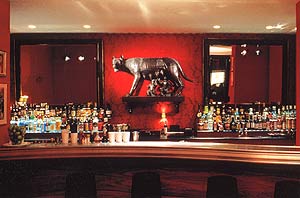 View into the café-restaurant Roma after reconstruction by Ingo Maurer with pictures from the Pfefferle Gallery and frames from the Pfefferle Frame-making Workshop |
|
 |
||
|
|
||
|
|
Works by artists of the Classic Modern period hang in the Frantz Liszt Bar. |
|
 |
||
